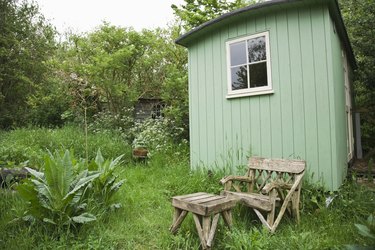 Orientation and structural decisions determine how warm an unheated shed can feel. Image Credit: Jupiterimages/BananaStock/Getty Images
Orientation and structural decisions determine how warm an unheated shed can feel. Image Credit: Jupiterimages/BananaStock/Getty Images
Asking exactly how much warmer a shed is than the outdoors has a single answer: it depends. The precise temperature of an unheated shed depends on both structural and environmental factors. If you are building a shed, decisions you make about construction, location and spatial orientation will help determine the temperature differential between unheated indoor and outdoor temperatures. For an existing shed, you can take varied measures to improve the shed temperature.
Orientation
If you are erecting a shed, several elements of choosing a site can determine whether your shed is warmer than or similar to the outdoors. Locate windows on the south side, where they can absorb maximum sunlight all year round. If that is not possible, east- or west-facing windows can capture sun warmth for part of the day. Keep your shed away from large shading trees and observe how outcroppings, hills and other large features of your topography affect the building's access to sun warmth. While windows capture sun, they increase a building's vulnerability to prevailing and potentially chilling winds. Another source of the sun's warmth in many yards is the driveway. Pavers, blacktop and concrete all retain heat. Use this source of radiant warmth by locating your shed close to the driveway. If yard space is small, place your shed against a house wall or the inside corner of two house walls. This lean-to strategy lets your shed benefit from small amounts of radiant heat and the existing insulation in your house walls.
Wind
Wind chill describes the effect that moving air can have on how cold you feel. One of the major functions of insulation in a building is to block the flow of wind. For an unheated structure in a cold climate, insulation in the roof and walls, insulation around an open foundation and weather-stripping around windows and doors may make the difference between using your shed in the winter and abandoning it until the weather warms. It can be essential when deciding whether to install water and plumbing. Walls facing the sources of most cold weather can be blank, windowless and insulated against prevailing winds, keeping your shed warmer.
Damp
Moisture in the air can make air feel warmer or colder. Your choice of foundation materials and height can determine whether your shed feels chilly and damp during cold months. A dirt or gravel floor or a slab level with the ground lets moisture from wet ground accumulate inside the shed. Building a foundation that extends above ground, even by a few inches, and insulating around it can make your shed feel warmer than outdoors during rainy weather.
Other Chill-Abatement Techniques
Keeping your shed warmer than the outdoors may require a number of strategies, rather than a single solution, and local conditions have a major impact on success. According to the University of Missouri Extension, for example, sheltering a structure from heavy winds with a windbreak of trees can substantially lower heating costs, up to 40 percent in some cases. In an unheated shed, the dividends can be both actual and perceived warmth. In a small yard, hedge-height plants and bushy shorter shrubs can block wind flow against shed walls. Paving around your shed can make it look more attractive while ringing it with warmth from sun-soaked pavers. Matting on a floor and shutters or heavy curtains on windows reduce chills caused by drafts.


